We’ve already seen more than a few bizarre cult beliefs of the urbanite bugcreatures. Streets being places that children played in might have been the weirdest, but there are plenty of others.
Today we encounter another, as we find out that suburbanites are subsidized by the mega corporations that own skyscraper, and this is bad. Also, dem poor inna city keedz subsidize dem rich crackas in dem suburbs. I know that might sound like a really strong claim, but don’t worry, the math checks out.
This is Lafayette, Lousiana. Like most American cities it’s broke. It’s full of aging infrastructure in desperate need of repair, and not enough money to maintain it. But unlike most American cities Lafayette acknowledged this fact and requested the help of Strong Towns and Urban3, a consulting company that helps cities better understand the economic impact of development.
Ah yes, Chucky Marohn and Strong Towns.

I actually bought that book of his, “Confessions of a Recovering Engineer.” According to Kindle, I made it 24% of the way through before putting it down forever, totally disgusted with the astonishing superficiality of his analysis. I considered doing a book review, at least of the first few chapters, but then decided to pass, since this was before the Urbanite explosion on YouTube.
Just to give you a sample of the kind of bloviation, here’s a quote from page 52 of 249.
When a licensed engineer references Level of Service for a local street, especially one at the very core of their community, it is a tell. It is an indication of a broad misunderstanding of the difference between a road and street, of deep confusion over what it means to build a place and how that is at odds with a driver’s level of comfort. We would expect such professionals, if they are intellectually consistent, to live in a home built almost exclusively of hallways.
They don’t, and neither should our cities. Keep LOS for roads where it is very helpful, but never allow it to be applied to streets.
Jaime, can you pull up the definition of road please? Let’s check the synonyms.
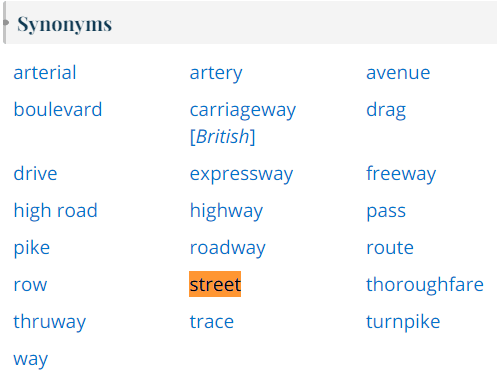
Okay that’s a bit odd. Let’s see the synonyms for street.
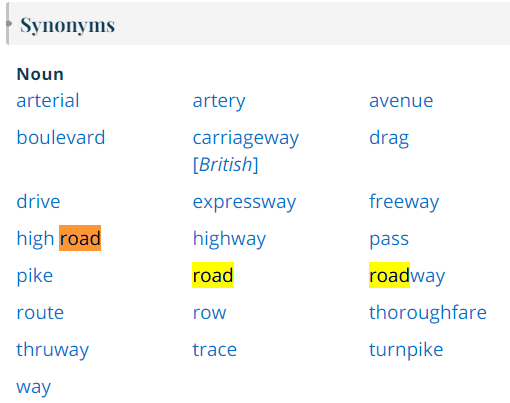
Now is not the time or the place to debunk the traffic trannies basic misunderstanding of the road system. That’ll come in a later piece. For now just understand that Chucky Marohn and Strong Towns serves as the intellectual bedrock of much of the Urbanite’s nonsense, and he’s about as intellectually rigorous as a my very lovable and very stupid Golden Retreiver.
But I’d rather show than tell, so let’s continue with Not Just Bikes video. We’re skipping ahead a little bit, and getting back to his Lafayette example later. Now he’s whining about Eugene, Oregon.
So let’s look at another city, Eugene, Oregon. Here’s the urban3 map of taxable value per acre. Once again downtown is clearly visible.

Not Just Bikes and the Urbanites here to give us the shocking insight that downtown areas have higher tax revenues per acre. I had no idea that this was the case. I honestly thought that single family homes on the outskirts paid just as much in property taxes per acre as multinational corporations who own skyscrapers in downtown Manhattan. Same for rural farmland in the Dakotas.
(5:20)
By the way, here’s what that 3D map of Eugene looks like from below. The red spikes correspond almost perfectly to modern car centric suburban developments. A visual reminder that car dependent suburbia is being subsidized by productive urban places. The data from Urban3 makes the subsidies visible, and makes it very clear who’s subsidizing who.
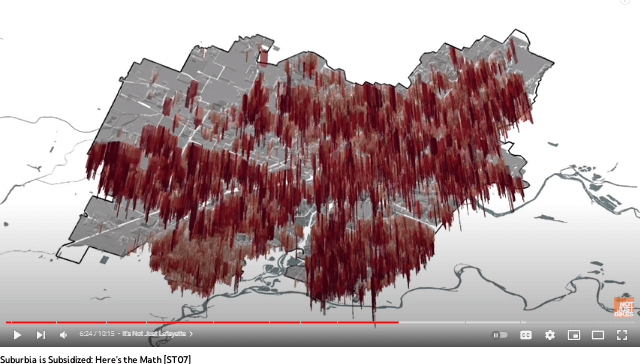
You hear that you ****ing CaRBrAiN? Car centric suburbia pays less in property tax because it’s less productive. It’s definitely not because it’s inherently less expensive/valuable land, and poorer people own less expensive land. You’re just not as productive, suburbanite. The numbers don’t lie.
In Eugene, Urban3 analyzed nine categories of development. Residential, mixed use, and commercial, in low, medium, and high density. And here’s what the average revenue for the city looked like after taking into account the servicing of these properties.

In the case of Eugene, the low density suburban housing is being subsidized by everything else.

What the urbanites are doing should be fairly obvious at this point, but it gets even dumber. After all, Eugene, Oregon doesn’t have many tall buildings, and certainly no skyscrapers. That’s not the case for some of the cities that he mentions next.
People may look at this and say ‘but I want to live in a low density single family home,’ and that’s fine, but only if you’re also willing to pay for it.

I’ve heard of tactical libertarianism before. This is somehow dumber. It’s like “tactical capitalism,” or something. How dare the ultra rich people and corporations who own the downtown land be forced to partially subsidize the families living in the suburbs! And this is coming from people who have never met a Government train infrastructure project that they didn’t love.
Yes, even California high speed rail. A project so unbelievably terrible that the French corporation they were working with ragequit and went to North Africa instead. So sometimes it’s okay to massively subsidize things like public transit, with vaguely socialist justifications. Oh but multinational corporations subsidize people’s homes? What is this the Soviet Union?!
Anyway, back to NotJustBikes.
Here’s the tax revenue/acre for South Bend, Indiana. See if you can spot downtown.

Or here in Charleston, South Carolina.
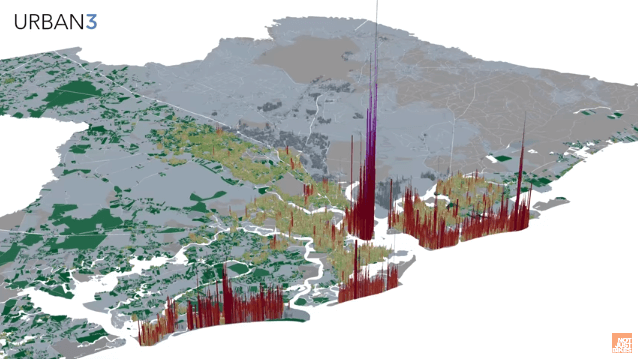
Or in St. Paul, Minnesota.
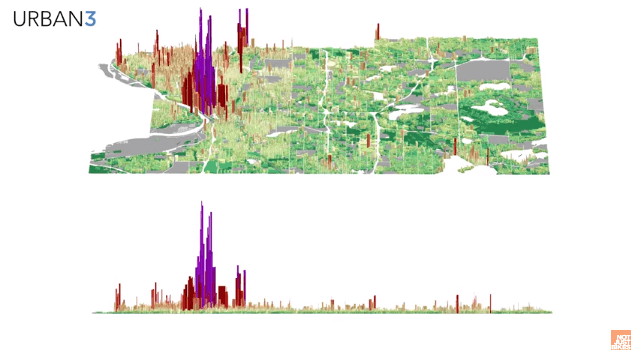
And here’s the entire state of New Hampshire, with all of the traditional downtown neighbourhoods clearly visible.

I see them Jason! I see all the areas that you need to have tons of money to own land in! I see them clearly Jason!
In every case, in every region Urban3 has analyzed, traditional mixed use walkable neighbourhoods dramatically outperform car-centric suburbia.
What these morons actually “found” is that ultra expensive downtown land is more expensive than random farmland in the middle of nowhere. They then concluded that this is because skyscrapers create wealth or something.

Or wait no, it’s actually mixed use development or whatever.
But in North America we’ve made it difficult, or even impossible to build new neighbourhoods this way, because of modern zoning and other car centric regulations.
Sure, zoning can be bad when done undemocratically, but NotJustSoy didn’t show that, and neither did Urban3. What they showed is that the inherently more expensive land in downtown areas is… more expensive, and therefore pays more in property taxes. Then they passed this off as a genius insight.

No, they did not control location, or anything else. They looked at it purely from a price per acre standpoint, and concluded that yes, more expensive land is more “profitable,” from a tax revenue perspective. I really can’t explain how fraudulent this analysis is. It’s almost too stupid to critique.
Of course, these mathematics apply outside of America as well. Here’s a map of Auckland, New Zealand. And you need to zoom out significantly to see downtown, because it is so financially productive.

Wow! Look at how productive that walkable, mixed use land is. Can we see a picture Auckland, New Zealand to figure out what secrets the Kiwis are holding from us? I’m sure we’ll see lots of quaint four story mixed-use apartment buildings, right?
 The secret appears to be building skyscrapers, which, curiously, is exactly the thing that Adam Something (Adam Kovacs) was whining about in the last piece. I guess he was wrong, because if only we just build skyscrapers everywhere, we’ll magically have highly “productive” land too.
The secret appears to be building skyscrapers, which, curiously, is exactly the thing that Adam Something (Adam Kovacs) was whining about in the last piece. I guess he was wrong, because if only we just build skyscrapers everywhere, we’ll magically have highly “productive” land too.

Am I doing it right?

How about now?
So what do we do with this information? Well our cities, through their policies, can decide what kind of developments they encourage.
Just zone this farmland for skyscrapers only and we’ll be mega rich in no time.

The analysis by the Urbanites is so stupid that it isn’t worthy of critique. By their analysis framework, rural farmland is inherently bad because it is not very valuable per acre. Therefore it should be coded as mixed use high rise apartments, so that they can be very valuable while being almost entirely empty. If you can magically “induce demand” for road transportation, why not living quarters?

In reality, land usage follows the inherent cost of the land itself, which is shaped by supply and demand. The cost of farmland in the US is estimated at just a touch over $3k/acre. Said farmland looks like the above. In contrast, Hong Kong, the city with the most skyscrapers in the world, looks like this.

And like this from the air.

What does an acre of empty land in Hong Kong cost? Does it cost 3k per acre?

A group of Hong Kong investors paid the government about $935 million for a 1.25-acre undeveloped piece of land in the coveted Victoria Peak neighborhood, Shawna Kwan reported for Bloomberg.
At $935 million per 1.25 acres, that works out to $748 million per acre, or about 250,000 times more. And in 2017, the city of Hong Kong sold a 0.7 acre lot for over $3 billion dollars, or about $4.3 billion per acre. It had a car park, which the developers tore down to build a skyscraper on. So they didn’t just pay for a vacant lot, but for the right to then spend more money demolishing the existing structure. Although when you’re already spending three billion for just over half an acre, who cares about demolition costs for one of these?
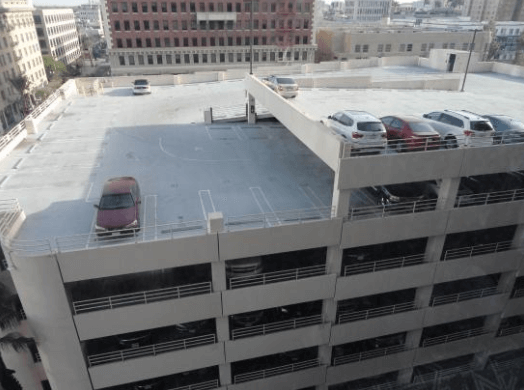
Undeveloped land in Hong Kong can be worth over a million times more per acre than farmland in the US. The owners of said land, at 1% property tax rates, will pay about $30,000,000 per year, as opposed to $30 per year for the farmer, per acre. I guess every municipality should just have vacant lots that are worth a billion per acre. Tax revenue problems solved.
By the dumbass midwit logic of the traffic soyboys this undeveloped land sitting there doing nothing is more “productive” than farmland that is being used to grow food, because it is more expensive. Therefore it is a criminal injustice that the multinational conglomerates who purchase this land have to pay more than their “fair share” in taxes to subsidize everyone else.
No really, this is what they believe. That the people who own extremely valuable land are being forced to unfairly subsidize people who own less valuable land. They then try to reframe this as “poor inner city people subsidizing rich suburbanites,” instead of “ultra rich mega corporations subsidizing everyone else.”

Let’s make this a bit more personal, shall we? Above we see Jeff Bezos. Below we see Elon Musk. Pick whichever of them you hate the most – for me it’s about equal – and then imagine them purchasing a block of land in Manhattan for a cool $250 million.

How did I get that number? According to Bloomberg, a study that looked at the selling costs for empty lots in Manhattan concluded that the entire useable land is worth $1.75 trillion. Since the area of Manhattan is 14,611 acres, this works out to an average price of about $120 million per acre. Manhattan city blocks are fairly small, and work out to just two acres each. So Mr. Moneybags buys up a city block, demolishes everything, and builds himself a single family home complete with a pool right here.
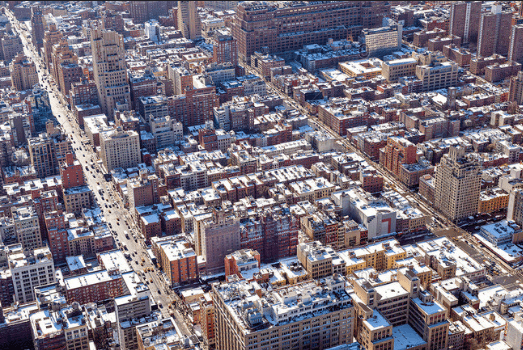
The value of his house would be approximately $250 million. Therefore he would pay about $2.5 million per year in property tax. However, the services that the city would need to provide him, like water access, etcetera, would be less than they would make in “profit” by taxing him. Therefore he is very oppressed by this taxation, and should be taxed less.

“The urbanites are saying I pay too much in property taxes.”
For the record, Urbanite twats love avoiding crime, and I highly doubt their analysis of the real costs to a city of dem inna city keedz has been rigourously calculated, or even calculated at all. Nevertheless, I can easily accept the premise that ultra rich land owners in downtown areas subsidize poorer land owners. And that’s a good thing.
Although it would be more accurate to say that the more expensive the land, the more the land owner will subsidize the municipality. Remember that graphic for the cost/price of various projects for Eugene, Oregon? It’s odd that they didn’t include an “ultra high density” fourth column with skyscrapers…

It’s almost like they found out that people build higher density stuff on more expensive downtown land. But that couldn’t be the case. It has to be that high density mixed use buildings provide value, totally independent of location.

Question: Is the above image of Hong Kong, or a random rural area where people decided to build high density because that makes land more productive? I know, it’s a real tough one here. Am I looking at a high density city or rural Kansas? It’s gonna go down to the wire here, because people can build ultra high density buildings wherever since they magically provide more value somehow.
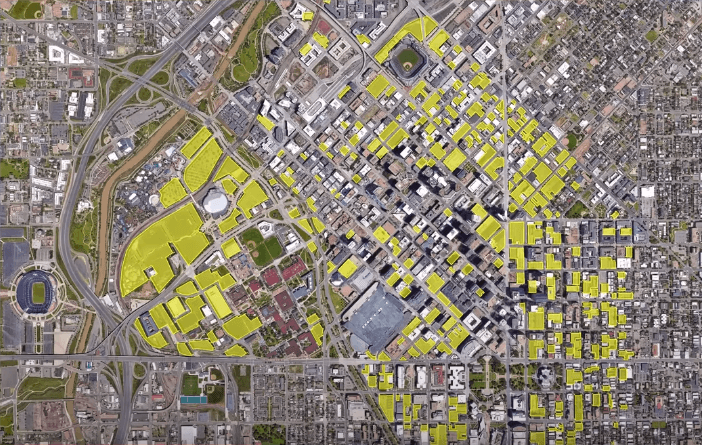
By the way, one of the more common uses for vacant downtown lots is to turn them into surface parking lots while they await construction. By the Urbanite Midwits own analysis, downtown surface parking lots are therefore more “productive” than just about any other form of development, since the owners pay more property taxes per acre. So make as many surface parking lots as possible.
So which path will the financially struggling American cities choose for their future? They can decide to make it easy to build mixed use walkable neighbourhoods, making good use of land and encouraging walking, cycling, and public transit. Or they can build more of this garbage, and go bankrupt.

Seems like a pretty easy decision to me.

Downtown areas are inherently more valuable than random areas out in the middle of nowhere. The areas where suburbs exist are somewhere in between. I, Not Just Bikes, am a moron who doesn’t understand the basic fundamentals of real estate.
There you go Jason, much better. I appreciate the honesty.
I’d like to thank my supporters on Patreon, who pay me to mathematically annihilate the suburbs, in 3D.
We did it Reddit! We mathematically annihilated the suburbs by showing that multinational corporations who own vacant lots in Manhattan pay more in property taxes than families in suburbia.
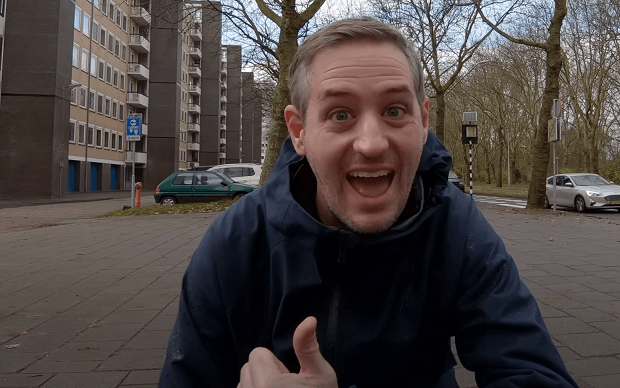
How will suburbia ever recover?

I could end this piece here, but the start of the video he covered Lafayette, and accidentally uncovered something else that they totally misinterpreted.
And that brings us back to Lafayette. This is a map of the revenue and expenses data uncovered by Urban3. So what are we looking at?
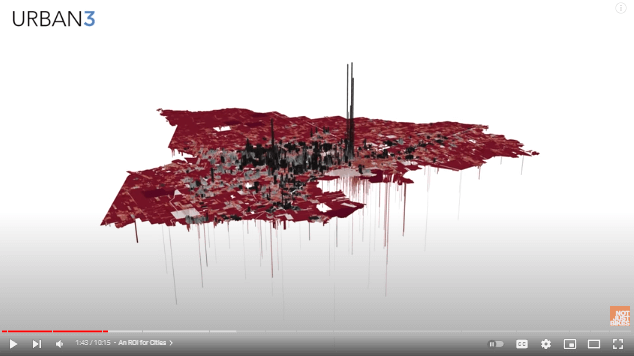
Urban3 claims to have “painstakingly” calculated the expenses in terms of city services needed for certain areas. It is much more difficult to debunk their calculations of expenses, and I don’t care to bother. We also don’t need to in order to show how faulty this analysis was.
This analysis has some fascinating results. The first is that downtown is wildly profitable.
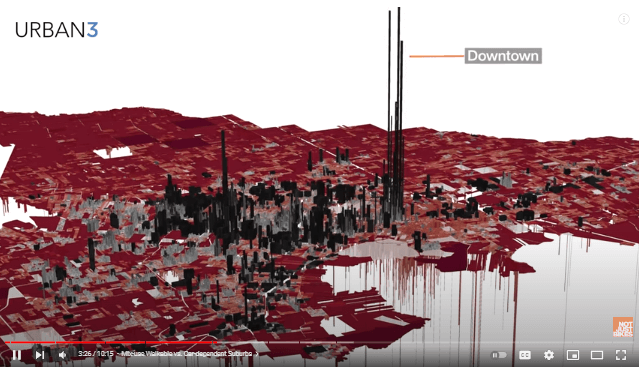
This is a bit surprising, because there’s nothing particularly remarkable about downtown Lafayette. It’s certainly not bad, but you’d never know by looking at the pictures that this is the economic engine of the city.
We covered this in the previous part of this piece. Jason Slaughter, Charles Marohn, and the guys at Urban3 are morons who don’t understand that location influences property values and therefore property taxes.
[He whines about Lafayette families needing to pay more in taxes to cover a supposed budgetary shortfall]
But those simple averages are hiding the bigger picture of who’s subsidizing who. Because these grey sections are the poorer areas, while these red areas are significantly wealthier.
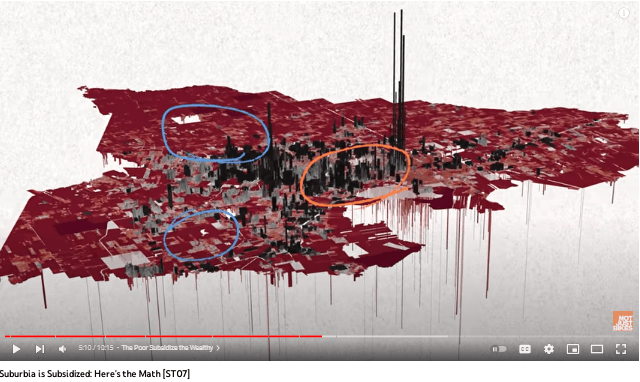
To prove his point he includes images of the “poor” neighbourhoods that subsidize the rich neighbourhoods. Of course, the wealth of tenants, and the wealth of landowners are two very different things. But then again, the cost of a parcel of land and its economic “productivity,” are two very different things.

Emma was excited to learn that White suburbanites were getting money from negroes in the inner city. She was later disappointed to find out that it wasn’t real.
However, in this case they stumbled upon a different effect. It’s called the Shaniqua Question.
So here’s a fun quiz. Which of these two neighbourhoods is subsidizing the other, number 1 or number 2? Yeah it’s the first one that subsidizes the second.
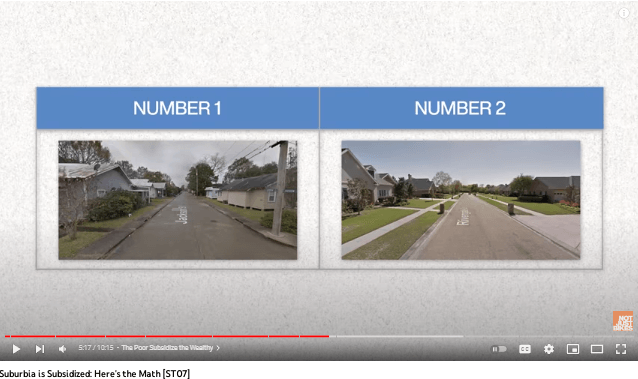
Oh my goodness what a crazy situation! What an absolute conundrum! What could possible be causing this calamity?
The poorest people in Lafayette are consistently subsidizing suburbanites.
You’d think that the exact opposite would be the case. That rich people would be subsidizing poor people in a myriad of ways, from welfare to higher property tax. But ACKSHUALLY these poor Lafayettes of Colour are being forced to pay more in property taxes for literally no reason.
Let’s check with the Strong Towns research in Lafayette to make sense of this.
There are two distinct areas that are profitable. The first is the core of the city, the historic downtown located in the center of the map. The second is a crescent of green that lies just to the east of the downtown. This includes the poorest neighborhoods in the community, areas that are in extreme distress.
Here are photos of these neighborhoods. The core downtown is improving but still struggles in many ways. It doesn’t pass the eye test for prosperity. The poor neighborhoods are worse and would be considered blighted by any standard.
He includes an image of the poor neighbourhood on the left, and the mediocre downtown on the right. He then concludes that, since the property values are relatively high, these poor folx are subsidizing da rich folx.

First of all, he doesn’t actually give us any numbers for the specific properties that we’re looking at, and is using wishy-washy language when he says that these are in the poorest neighbourhoods. Presumably he found the absolute most rundown properties he could find and snapped a few shots out of context. Aside from the mess in front of one of the houses, it looks quaint.
But let’s accept his premise and take a quick look at Lafayette’s demographics for a second.
According to the most recent ACS, the racial composition of Lafayette was:
- White: 62.77%
- Black or African American: 30.53%
- Two or more races: 3.38%
- Asian: 2.29%
- Other race: 0.67%
- Native American: 0.22%
- Native Hawaiian or Pacific Islander: 0.13%
Gee, I wonder where Da Blax live. Could it be the extremely valuable inner city land that they are in the process of ruining? I can’t find a map of Lafayette, but I could find one of Pittsburgh, which showed Shaquan squatting on valuable downtown land.
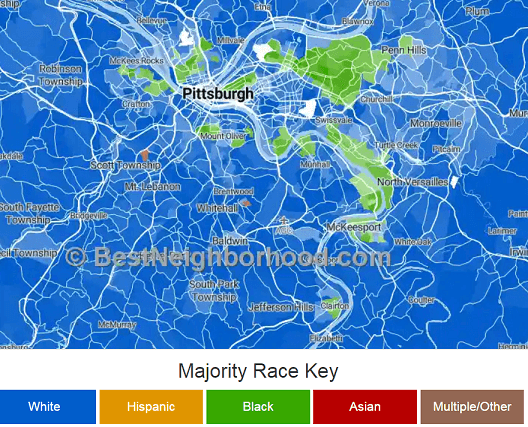
How does Strong Towns reframe this?
What becomes obvious with this map is that the poor neighborhoods are profitable while the affluent neighborhoods are not. Throughout the poor neighborhoods, the city is already bringing in more revenue than they will spend to maintain the neighborhood, and that’s assuming they actually maintain the neighborhood (which they have not been). If they fail to spend the money on maintenance, the profit margins will be even higher.
This might strike some of you as surprising, yet it is important to understand that it is a consistent feature we see revealed in city after city after city all over North America. Poor neighborhoods subsidize the affluent; it is a ubiquitous condition of the American development pattern.
These retards found out that gentrification is a thing for a reason and then reframed this as the poors subsidizing the rich.
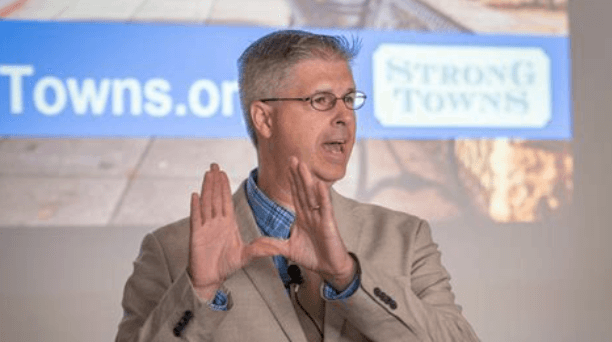
Of course, when you factor in policing I highly doubt that these poor neighbourhoods are anything other than a burden, even when their higher property values – due to location – and therefore property taxes are factored in. But even accepting the premise, what actually happens in America is that White People build a beautiful city. Then Da Blax come in and eventually ruin it with crime. White People flee their ancestral city, or at least the inner city parts, and the zionist media reframes the victims as “White Flight”ers.
The blacks proceed to run down an inherently very valuable area. However, it will always retain higher value than it would appear to have from pictures, or analysis of average incomes in the area, due to the excellent location. The potential for White People to move back in, and turning the land into the productive area that it ought to be gives a huge incentive for developers to attempt to “gentrify,” an area. This leads to whining from the original racial cleansers that “their” land is being taken from them. It also leads to dipshits like Charles Marohn concluding that the land Shaniqua and DeQueerus are squatting on in downtown is being overtaxed or something.

Also, the image on the right is clearly just low density in action.
Here are the pictures of the rich areas that “get subsidized” by the poor areas that are located downtown. Gee, do you think that maybe if you transported these nice suburbs to the inherently valuable downtown areas, and transported the slums to the outskirts, that maybe the land value would be switched? I think it would, but Chucky Marohn is here to tell us all about:
THE FINANCIAL PRODUCTIVITY OF BLIGHT

As an example, consider what is probably our most famous case study here at Strong Towns, the Taco John’s in my hometown of Brainerd, Minnesota, as described in “The Cost of Auto Orientation.”

I try not to overuse the term midwit, but there really is no other way to look at these people. Dumb people look at slums and think that they’re a burden on society. Intelligent people look at slums and think they’re a burden on society. But there’s a certain archetype of snarky midwit who looks at urban blight, calculates some theoretical property tax value, and then explains how ACKSHUALLY this is super “profitable” to the city.

Druggies do the trick as well.
Don’t you see you stupid CaRBrAiN nATZeE. Super high crime areas of the city where no one wants to go due to druggies and criminals of colour squatting in the area are great! Since the property values will stay high due to the latent potential of the areas, the property taxes will be higher, and that means that they’re good. Also, the poor druggies of colour are forced to subsidize you through their property taxes.
What’s that? You say that any downtown apartment building will probably be owned by a slumloard, so it’s not even the same people paying the tax as living in the area. Maybe, but I can’t be asked to keep track of every single incorrect snuck in premise here or we’ll be here forever.
Yesterday I wrote about Lafayette, Louisiana, a perfectly normal American city that shares the basic development pattern most of you have in the places you live. I included a map that shows parts of the city that were profitable — where the city collects more revenue than is spends — and parts of the city that were being operated at a loss, where the long term expenditures are greater than the revenue stream.
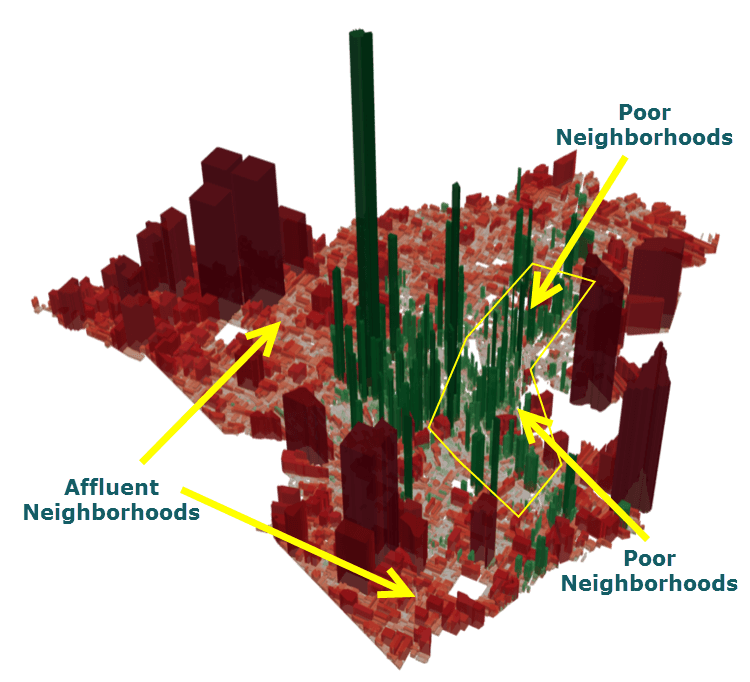
I’ve (rather crudely — I’m not a graphics pro) updated that map to show the parts of town generally full of residences occupied by poor people and parts of town with residences occupied by those that are more affluent. I used the terms “poor” and “affluent” rather loosely. There is no study that breaks this down and we don’t have underlying data. That being said, when we were looking for an AirBnB to stay in, we were told to stay away from the neighborhoods marked as “poor” as they are dangerous. When we spoke to law enforcement as part of our study, we received similar insights. A look at Zillow, backed up with an eye test, also suggests that the areas marked poor are indeed occupied by people that are, on average, significantly poorer than those people living in the areas marked affluent.

Again it’s probably true that the affluent neighbourhoods are places where people own their own homes. In contrast, the mysteriously violent Poor-Americans are living in downtown areas where they don’t own their own homes. But Marohn makes sure not to say this explicitly, because “these rich landlords aren’t paying their fair share of taxes,” is a bad look.
We do see some sanity in the comments section.


Yes, in addition to “discovering” that downtown inner city areas are more expensive per acre, Strong Towns has “discovered” that Da Blax are squatting on some of the nicest land in America.

RJSchwarz points out another obvious limitation of the study, which is that they don’t seem to account for policing costs anywhere. They definitely do not account for the societal cost of crime, like good little urbanite antifas.

And Cindy points out that the affluent areas are a different municipality, and therefore can’t be subsidized by the inner city landlords property taxes anyway. I can’t verify this, but it doesn’t surprise me to hear that.

The Urbanites remain very serious intellectuals. Next time it’s the “Suburban Ponzi Scheme,” and SPOILER: It’s not real.





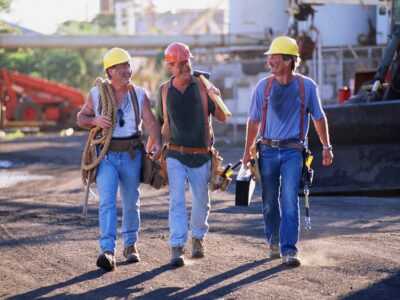





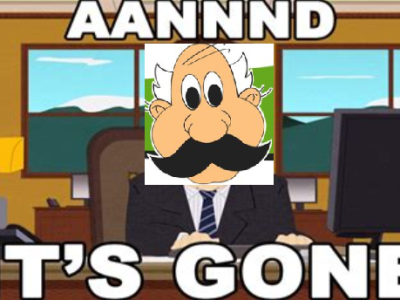


Q: “Why can’t we have nice walkable cities like Europe?”
A: Niggers
It’s so glaringly obvious that they have to make up elaborate lies and try to dazzle you with information like a con man to try and get you not to look at the root causes.
Please remind these people that “walkable cities” is a neon notsee dog whistle and watch them squirm.
[…] PSA: Deboonking the Traffic Soyboys Part 22 – Skyscraper Owners Pay More than their Fair Share… […]